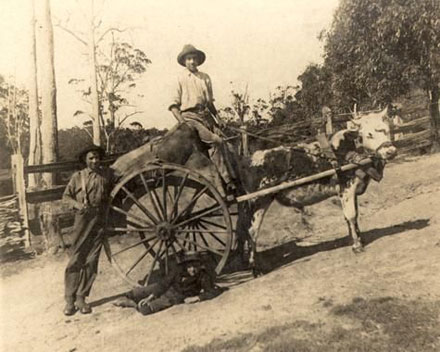
This year marks the 21st anniversary of the Maleny Wood Expo on the Sunshine Coast of Queensland, which celebrates the region’s proud history of timber-gathering. The theme for this year’s annual event is “From seed to fine furniture”with activities over three days from April 29. Source: Sunshine Coast Daily
The festival is an ideal time to get a glimpse of the skills of the early timber-cutters, see the best in both handcrafted traditional and high-tech tools and smell the spicy aroma of newly-milled timber.
It is a tale of the region, how it grew and how it have changed.
The timber-getters and their bullock teams which worked the big timber forests are long gone but they played an important role in the development of the early settlements.
In most cases, the timber-getters came to the area well ahead of the pioneering families who later toiled to turn the cleared areas into farmland.
Townships soon sprang up close by and the timbermen were able to advise the settlers where the best land was located for future farming pursuits.
While exploring the Brisbane River in 1823, John Oxley was impressed with the magnificent timbers of a species of pine which was undiscovered at the time. This tree was the hoop pine which has a distinctive pattern in bark of the tree.
The Moreton Bay region opened up to free settlement in 1842 and, at that time, the colony did not have a sawmill.
Logged timber was either pit sawn and used locally, or shipped south for milling and exported overseas.
Prior to the railway opening in the early 1890s, timber was sent by boat from Campbellville, on the junction of Mellum and Coochin creeks, down through Pumicestone Passage or by sea from Mooloolah Heads.
Once the railway was established, the bullock teams hauled the sawn timber from the sawmills to the railway stations to be loaded onto trains for the journey to Brisbane.
It was not uncommon to see many bullock teams in and around railway yards at the one time.
Of all Queensland’s natural resources, timber was the most visible and abundant to the first Europeans arriving on the Sunshine Coast.
Timber is frequently referred to in early accounts of the Near North Coast’s early history, with descriptions of the extensive stands of timber which lined the coast and riverbanks as well as the hill country of the Blackall Range and beyond.
In south-east Queensland, the dominant timber species were soft woods such as hoop and bunya pine, as well as other cabinet timbers.
Another rainforest tree of major significance was the mighty cedar tree, which was found all along the eastern coast. Some of these trees were more than three metres in circumference.
Cedar cutters had already shown interest in logging this species that grew throughout parts of the region by the 1800s. By 1906, cedar faced commercial extinction and a third of Queensland’s hoop and bunya pine had been removed.
These trees provided worthwhile rewards for some of those enterprising timber workers and once areas were cleared of prized timbers they were turned into farmland.
The timber-getters were usually on contract and cutters sometimes worked in pairs but some worked alone.
The bush men wielded axes and other tools of their trade such as the cross-cut saw, barking bar, maul and wedges and brush hook.
The brush hook was an important tool which was used to clear a track so the bullocks had an open pathway, as they could be injured by being staked on a sharp cut sapling.
A good bullock was a valuable resource and two good leading bullocks were essential for the smooth operation of the team.
Almost as important were the two bullocks at the rear known as the “polers”. Mustering and yoking up to 24 bullocks could take up to two hours.
Each bullock had a name and recognised it when spoken to. Once the power of bullock teams became available, logs were hauled along tracks for great distances to a waterway or to “chutes”, which allowed the logs to be launched over the escarpment to slide to the bottom where they were hauled by bullock teams or rafted to a mill or transport hub.
Chutes saved the timbermen travelling many long and arduous kilometres getting logs from the hills and plateaus down to where the bullocks could snig or cart the logs on a bullock wagon to a mill, ship or railway line.
A bullock driver’s day started at daybreak and did not finish until nightfall. On the hills of the Blackall Range there is evidence of chutes and many of the lookouts in the high country overlook the original chutes.
Used frequently over long periods, these steep sliding tracks became known by the people who were first associated with them, such as Landers Chute and McCarthy’s Chute.
To “shoot” a log meant it was sent end over first, although it sometimes changed course on the way down, smashing into other trees and boulders on its passage down the steep slopes.
Today when we look at the topography of the highlands behind the Sunshine Coast it is hard to imagine the sawing and crashing of timber, the thundering sounds as the logs hurtled down the chutes and the crack of the bullockies whip as he manoeuvred the teams over rough old bullock trails to get his precious cargo to the timber mills.
Thanks to Sunshine Coast Council’s Heritage Library Officers for the words and Picture





